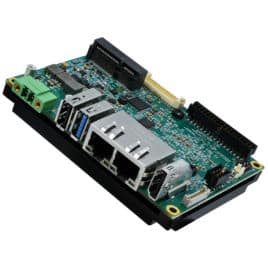A single-board computer is a fully functional CPU built around a single circuit board. The input/output (I/O) processor, memory, and microprocessor—all components essential for a computer—are all present in single board computers. While fully functional, single-board computers lack expansion slots for add-on devices like printers and scanners. Its features are all built-in. These devices are made even more practical by having a variety of pre-configured models.
Uses of A Single-board Computer
One of the main uses of a single-board computer is as an embedded controller. They have applications in a variety of sectors, including telecommunications, automobile, medical technology, automotive, and household appliances. Single-board computers can be used in, for instance, the following systems or applications:
- Traffic light operators (traffic management)
- Computerized medical imaging systems
- Vehicle anti-lock braking systems
- Missile defense systems
- Automobile stability control systems
- Gaming consoles
- Mobile phones (telecommunications)
- Thermostats (home appliances)
- Industrial process control systems
Key Features Of Single-board Computers
Single-board computers can meet a plethora of application needs due to the following features:
- Easy integration due to compact size
- Ruggedized to withstand shock, vibration, and severe temperatures.
- Include Ethernet and USB host interfaces
- Offer extended temperature ranges
Single-board Computers Vs. Desktop
SBCs are built using a single circuit board, whereas desktop computers are built using multiple boards. Single-board computers can be modified or enlarged in terms of functions, but they are not expandable. Desktop computers, on the other hand, contain expansion slots that allow the addition of extra features.
Perhaps the most fundamental difference between single board computers and desktop computers is their market. Compared to desktop computers, single-board computers are marketed toward niche markets and are designed for regular use in offices and commercial spaces. Another factor differentiating single-board computers from desktop computers is the production cost. Standard desktop motherboards are mass-produced for usage in homes and businesses. As a result, they are less expensive to produce than single-board computers aimed at industrial customers.
Why Choose Single Board Computer Over Standard Desktop
In most cases, a single-board computer outperforms a regular desktop computer for these applications.
Useful in Severe Environments
Single-board computers are more suited for usage in hostile settings because they are more durable, shock and vibration resistant, and produce less heat.
Long Life
Single-board computers often outlast desktop computers in terms of lifespan, making them a more cost-effective choice for many industrial applications.
Suitable for Hobbyists and Home Use
Single-board computers are also widely used as development boards, home servers (such as media servers), and network-attached storage devices.
Conclusion
Single board computers were designed originally for industrial uses, but they are now slowly entering the domestic market. Single-board computers have become more popular because they are simpler to use. An SBC is an excellent choice if someone is looking for a simple computer that will do the job without breaking the bank. In the future, it’s safe to say that single-board computers will be used in even more applications as their price continues to drop and their features become more powerful and efficient.




